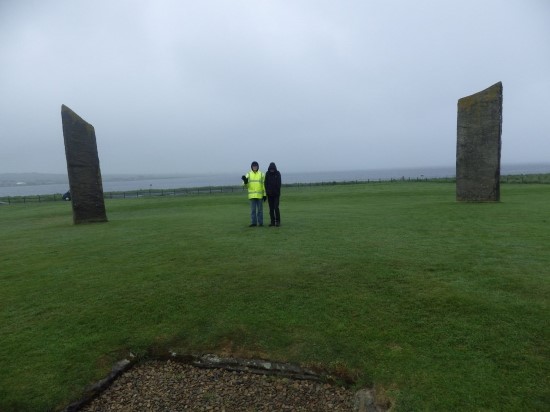Lessons from Orkney
(I wrote this in 2016 after a wet and windy summer solstice trip to Orkney, Scotland.)
I enjoyed a trip to Orkney last week to celebrate the graduations of my sons from high school and university. We chose to go to Orkney for three reasons. The first was to see its famous Neolithic monuments, which collectively form a UNESCO world heritage site. The well-preserved settlement of Skara Brae, the Ring of Brodgar stone circle, the Standing Stones of Stenness and the chambered tomb of Maeshowe are some of the oldest surviving and best preserved human-made structures in northern Europe; they predate Stonehenge and the Pyramids of Giza.

Although much of our understanding of the earliest Orcadians is subject to interpretation, there’s good evidence that they were part of a community of nomadic hunter-gatherers that extended throughout Europe. We don’t know exactly why they made these symbolic rings of standing stones, but we do know that thousands of man-hours were required for their construction. Although similar monumental structures were probably built by these people across Europe, those made of wood have not persisted. Orkney’s sites remain to amaze us because they are made from stone: Orkney’s climate, then as now, is too harsh for trees. If you don’t have trees, you build with stone.
Orkney’s Neolithic community endured from well before 3000 to about 2000 BC, when the sites were largely abandoned probably due to a climate that cooled and became less hospitable. Eventually Picts from the Scottish mainland occupied the islands. In the time of the Vikings the islands were annexed by Norway, but they were returned to Scotland in 1468 as part of a marriage dowry. Orcadian names and traditions reflect the contributions of both Scandinavian and British / Irish heritage, as does Orcadian DNA.
The second reason we visited Orkney was to see the puffins. I’ve longed to see puffins in the wild for as long as I can remember, a goal which was hastened by the recent addition of Atlantic puffins to the IUCN Red List of Threatened Species. This time of year, many seabirds nest on the rugged cliffs of the Orkney Islands, making Orkney an ideal spot for up-close birding. During our visit we went nose-to-beak with puffins, and also gannets, razorbills, guillemots and fulmars.
The third reason was personal. My great, great, great, grandfather William Sinclair was born in Orkney. Like many 18th century Orcadians, he emigrated to Canada to work for the Hudson’s Bay Company (Orcadians were favored employees as they could withstand Canada’s harsh weather). William’s son James, whose mother Nahoway was Cree, discovered the Sinclair Pass through the Canadian Rockies, which greatly enhanced Canada’s claim to western territories.
Orkney’s treeless landscape invites introspection, and during much of our visit I contemplated the forces that drive, and resist, human migrations. Orkney is in many ways a microcosm of human history, and tells the story of the complex interactions between humans and their environment. Early Orcadians came and went as they saw fit, arriving and dispersing as dictated by threats and opportunities. Orkney’s oldest inhabitants established a thriving culture and agrarian practices at about the same time those in the Indus Valley and in central China. Like the early Indus Valley inhabitants, their culture and society declined as a consequence of a changing climate; people literally moved to greener pastures. Still later, the Picts and the Norse moved in, and others, like my (3x)great grandfather, moved out.
As I sat with my sons watching the seabirds nesting just meters above the North Sea waves, I read that more than 1000 migrants and refugees had drowned the previous week in the Mediterranean Sea. Desperate to escape conflict and seeking safe haven for their families, they risked and lost everything.
My family tree, like yours and everyone’s, is full of stories of men and women who moved to flee hardship or find new opportunities; we are, after all, the descendants of those who survived. Orcadian resiliency stems from Scottish and Norwegian grit. William and Nahoway produced a son who was able to draw on both Orcadian and Cree traditions and culture, providing him with the tools he needed to become a great explorer. We are all migrants.
Orkney’s nesting seabirds are migrants too. Each year for a few months they gather on cliff faces in huge numbers to raise their chicks. A single cliff face supports hundreds of birds of several different species. Although densely packed, each pair finds a place to go about the important job of raising their young. But their community isn’t secure. Many of the species that nest in Orkney are under threat from changing fish distributions, rising temperatures, and increasing storm severity. Do the puffins blame the razorbills for their hunger? Do they plan to build a wall to keep out the gannets?
Standing inside the Ring of Brodgar, it’s impossible not to wonder where the decisions and choices we make today are leading us. What will we leave for our descendants? Will we be able to dodge the population and climate bullets, or will we let our tribalism and identity politics drive us to extinction? Five thousand years ago our Neolithic ancestors were intelligent, tool-wielding problem-solvers. Maybe if they were in our shoes they’d suggest that we set aside our differences and get to work, before it’s too late.
